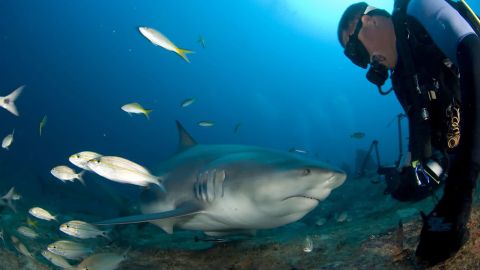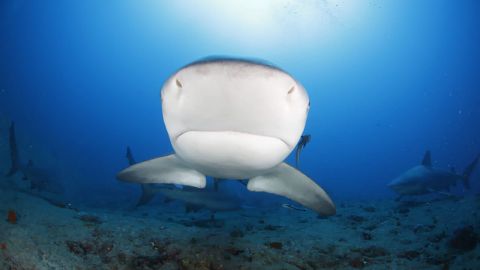Playa Santa Lucía, Cuba
CNN
—
The shark turns and swims directly at me.
There is only open water between us, no cage to protect against the approaching bull shark, the species considered by many scientists to be the most aggressive in the world.
I am beginning to have second thoughts about this assignment.
Before we entered the ocean, Oromelio “Oro” Rodriguez Salabarría, the Cuban scuba instructor next to me, swore he never had a client bitten by a shark. Not even a mordisco or a nibble.
I had hired local guides and spent weeks dealing with different entities inside Cuba’s sprawling bureaucracy to arrange a dive with these sharks. The government-run Shark Friends Dive Center, in the remote Cuban beach town of Playa Santa Lucía, is the only place in the country, one of a handful in the world, where divers can swim with bull sharks.
With more than 350 teeth, a muscular appearance and the occasional propensity to attack boats and people, bull sharks have a fearsome reputation. Still, attacks on humans are rare – while people regularly kill bull sharks for their fins, liver and skin.
Increasingly, some governments though – including here in Cuba – are looking to protect sharks and capitalize on the high of a close encounter, no longer fearing sharks will scare visitors off beaches, but will actually attract them. The Cuban government is promoting package tours where visitors experience the island’s iconic old cars and cigars followed by a dive with the toothy predators.
“People come to Cuba from around the world to swim with the sharks,” said Dan Whittle, senior director at Environmental Defense Fund, a non-profit group that in 2015 worked with the Cuban government, local scientists and fisheries to implement greater protections for marine life on the island.
“A live shark in the water in some of these national parks is worth hundreds of thousands of dollars,” he said. He estimates that shark tourism in Cuba adds up to millions of dollars annually.
Oro, a gray-haired, gravelly voiced scuba instructor with more than 20 years experience guiding shark dives, is enthusiastic about the appeal. “It’s the myth of the shark being dangerous, a maneater, that it is aggressive,” Oro says.
“Then you manage to see a shark a meter and a half away and when you come out of the water, you say, ‘This the best dive of my life!’”
Tour operators in the Bahamas have already discovered what a big business shark diving can be. According to a study in Biological Conservation, in 2014, divers visiting the Bahamas to swim with sharks contributed over $100 million to the local economy there.
While shark tourism in Cuba is a much smaller operation, guides are hopeful that the island’s pristine reefs and increased efforts to safeguard the approximately 100 species of native sharks will draw visitors who so far have been slow to return since the pandemic.


Before Covid, the dive center in Playa Santa Lucía used to attract shark buffs from around the world, guides said. Now clients are scant. Carrie Prevost, a Canadian tourist, was one of only a handful of recent visitors to opt to go swimming with the bull sharks.
“It’s a world I don’t belong in, and it’s very exciting to have opportunity to do this. I am both excited and nervous at the same time,” she told CNN.
As she suited up in dive gear for her first attempt to see the sharks, Prevost admitted that the theme song from the movie “Jaws” was playing in her head.
“I watched the movie very young, and I was afraid to swim in pools, let alone the ocean, so this is a challenge to overcome,” she said.
Marine biologists say that despite the widespread publicity that attacks on humans can generate, sharks usually do not present any danger and are necessary to maintain healthy reefs and fish populations.
Shark diving guides have worked to educate the local population on this point, making the case to local fishermen that the sharks can bring a tangible economic benefit.
“We tell residents not to kill them, not to fish for them. We are always working on that,” said scuba guide Lazaro Suarez Zayas. “The bull shark is not in danger of extinction, but it’s from this area, and we use it as a natural resource so we should protect them.”
Some guides, proud of their connection to the animals, say they believe the sharks recognize them.
As soon as he gets in the water for our dive with the sharks, Lazaro quickly spears a few snappers. He says he wants to draw in the sharks but not overstimulate them.
At a depth of more than 80 feet underwater, we swim by the wreck of a Spanish ship that sank more than a century ago and Lazaro turns to me and makes the sign of a fin on top his head with one of his hands.
At first, I don’t see anything in the piercing blue water. Then a bull shark emerges into view.
We sit on the bottom of the ocean floor as the shark circles around. It is longer than I am. Another shark arrives and the two quickly gobble up the fish that Lazaro dispatched. He feeds the fish directly into the sharks’ mouths, withdrawing his hand at the last moment before their teeth close down.

The larger shark fixes its midnight black eyes on me and heads in my direction. I remember what the guides said about not panicking, swimming off or thrashing in a way that would give the shark the impression I am injured or easy prey.
Even as my pulse quickens, it’s hard not to admire an animal so clearly in its element. The shark swims behind me. I swivel my head while motioning the “ok” sign to Lazaro and Oro.
It’s just checking me out… I think.
For a few brief seconds, the circling shark holds my full attention as if there were nothing else in the world. Will it attack or come in for an even closer look? What can the guides really do to protect me?
It is exhilarating to be just feet away – just as the guides promised me, this is already one of the best dives of my life. Thankfully, the fascination I feel for the shark isn’t mutual.
After a few close passes, the shark loses interest and slowly swims away.